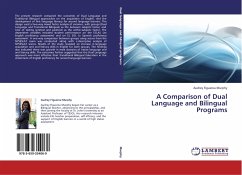The present research compared the outcomes of Dual Language and Traditional Bilingual approaches on the acquisition of English, and the development of first language literacy for second language learners. The design used a two-way mixed factor analysis of variance, with groups (Dual Language and Transitional Bilingual) as the between subjects factor, and time of testing (pretest and posttest) as the within-subjects factor. The dependent variables included student performance on the ECLAS (an English proficiency assessment) and on EL SOL (a Spanish proficiency assessment. A one-way comparison between groups using scores from the NYSESLAT exam was conducted along with a descriptive analysis of NYSESLAT scores. Results of the study revealed an increase in language acquisition and oral literacy skills in English for both groups. The findings also indicated there was growth in most domains of native language oral and literacy skills. The outcomes further suggested that the Dual Language approach was more effective than Transitional Bilingual Education in the attainment of English proficiency for second language learners.
Bitte wählen Sie Ihr Anliegen aus.
Rechnungen
Retourenschein anfordern
Bestellstatus
Storno

